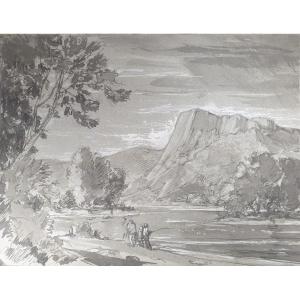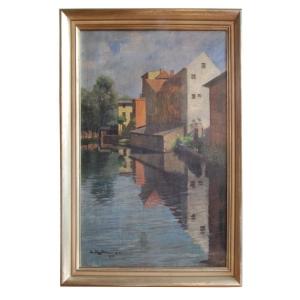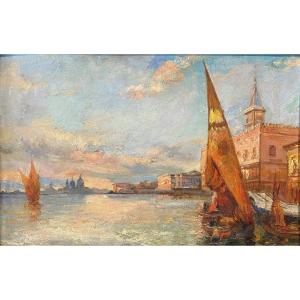Torgau (Germany), 1852 – Milwaukee (Wisconsin), 1919
Watercolor and heightened with white gouache
29 x 41 cm (45.5 x 57 cm with frame)
Signed lower left “F. Rohrbeck”
Very good condition
Beautiful gilded wooden frame
Franz Rohrbeck is a painter born in Germany who was part of a group of artists who came to work in the United States in the 1880s. He became a scenery painter after working as a panoramic painter in San Francisco. Rohrbeck was a member of the Society of Milwaukee Artists. He painted murals in Wisconsin, Minnesota, Iowa and Michigan. He also created several large paintings illustrating episodes from the life of Christopher Columbus. He is probably best known for his large mural, "The Spirit and Strength of Wisconsin," at the Wisconsin State Capitol.
Franz Edward Rohrbeck first studied at the Academy of Arts in Berlin and then specialized in portraits. In 1885 he crossed the Atlantic to Milwaukee with August Lohr from Munich, Friedrich Wilhelm Heine and Berhard Schneider from Dresden and Hermann von Michalowski from Berlin like Rohrbeck. They came to paint for the American Panorama Company of German-born Chicago businessman William Wehner. The company created huge historical and religious themed paintings that traveled across America.
For example, Rohrbeck participated in the creation of the panorama “The Battle of Atlanta” in 1864. The panoramic painting (or “cyclorama”) was a very large work in which nearly twenty artists could participate.
In 1898 Rohrbeck and other panoramic artists traveled to San Francisco to paint “The Battle of Manila.”
Rohrbeck was specilazed in portraying the Confederate troops in the battle scenes.
Our watercolor represents an Indian palace in Northern India with a Mughal style of Muslim influence, with the high mountains of Himalaya that can be seen in the background. Different characters animate the composition including a servant with a panther, a man on the terrace under a parasol and a couple chatting in the shade of a large tree. The main character of the composition may be this tree, impressive in its size and shape, and very decorative, perhaps as much as the palace itself. This is a magnificent Banyan, or Indian fig tree, the national tree of India.
This work may be a study for a panoramic setting, a project, a preparatory work for a panorama on the theme of India (with the characteristic elements of India: the palace, Indian costumes, the banyan tree and the Himalayas). Or is it a set design project for a play set in India ?










































 Le Magazine de PROANTIC
Le Magazine de PROANTIC TRÉSORS Magazine
TRÉSORS Magazine Rivista Artiquariato
Rivista Artiquariato